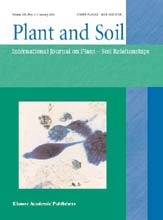| Journal Article |
 |
|
| Article Title | Nitrogen use efficiency of monoculture and hedgerow intercropping in the humid tropics | | Author | Edwin C Rowe, Meine van Noordwijk, Didik Suprayogo and Georg Cadisch | | Year | 2005 | | Journal Title | Plant and Soil | | Institution | Springer-Verlag | | Volume | 268 | | Issue | 1 | | Pages | 61-74 | | Call Number | JA0205-05 | | Keywords | Agroforestry, Competition, Complementarity, Isotope, Subsoil, Uptake |
|
| Abstract: |
| The design of productive and efficient intercropping systems depends on achieving complementarity between component species’ resource capture niches. Spatio temporal patterns of capture and use of pruning and urea nitrogen (N) by trees and intercrops were elucidated by isotopic tracing, and consequences for nitrogen use efficiency were examined. During the first cropping season after applying urea-15N, maize accounted for most of the plant 15N recovery in Peltophorum dasyrrachis (33.5%) and Gliricidia sepium (22.3%) hedgerow intercropping systems. Maize
yield was greatest in monoculture, and maize in monoculture also recovered a greater proportion of urea 15N (42%) than intercropped maize. Nitrogen recovery during active crop growth will not be increased by hedgerow intercropping if hedgerows adversely affect crop growth through competition for other resources. However, hedgerows
recovered substantial amounts of 15N during both cropping cycles (e.g. a total of 13–22%), showing evidence of spatio-temporal complementarity with crops in the spatial distribution of roots and the temporal distribution of N uptake. The degree of complementarity was species-specific, showing the importance of selecting appropriate trees for simultaneous agroforestry. After the first cropping season 17–34% of 15N applied was unaccounted for in the plant-soil system. Urea and prunings N were recovered by hedgerows in similar amounts. By the end of the second (groundnut) cropping cycle, total plant 15N recovery was similar in all cropping systems. Less N was taken up by the maize crop from applications of labelled prunings (5–7%) than from labelled urea (22–34%), but the second crop recovered similar amounts from these two sources, implying that prunings N is more persistent than urea N. More 15N was recovered by the downslope hedgerow than the upslope hedgerow, demonstrating the interception of laterally flowing N by hedgerows. |
|
|
Download file(s): Click icon to download/open file.
|
| |
File Size |
Description |

|
347 KB |
Softcopy |
|
|
|
| Viewed in 1972 times. Downloaded in 931 times. |